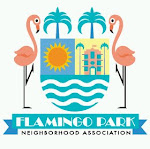The City Commission will decide upon whether to adjust the Flamingo Park Tennis facilities at its meeting on Wed, Apr 14, 2010. The discussion has been scheduled for sometime after 5pm along with a number of items of importance to the Flamingo neighborhood and other neighborhoods of the City, including consideration of an amendment to short term rental ordinance. In Sep 2009, the Commission adopted a plan for 17 courts and a new Tennis Facility. Controversy on whether the courts should be clay or hard surface has now led to a proposal to increase the number of courts.
The Historic Preservation Board at its last meeting approved the 17 court plan with the statement that the adopted plan fits the need for a balance in varied recreational facilities and green open space respite in a way that respects the original plan for the park.
Our neighbor and member Wanda Mouzon shares with us the following article and thoughts:
Here is a link about Urban Parks and lists some of the great Urban Parks. I have been to all but 3 of them, and I agree that they are all examples of successful parks. The key to this success is in the definition. The larger and more dense the city, the more important it is to provide residents a place to escape into nature and experience trees, grass, flowers and the like. These parks depict the many ways that this "escape" can be realized and is often based on the local climate, topography, etc. The important point is that if we allow Flamingo park to be consumed by single use recreations, this escape to nature is lost and the primary purpose for an urban park is not even achieved!http://architecture.about.com/od/landscapedesign/tp/cityparks.htm
Great City Parks
Landscape Design in City Parks and Urban Spaces
By Jackie Craven, About.com Guide
As cities grow, it has become important to set aside green space where urban dwellers can enjoy trees, flowers, lakes and rivers, and wildlife. Landscape architects work with urban planners to design city parks that integrate nature into an overall urban plan. Some city parks have zoos and planetariums. Some city parks encompass many acres of forested land. Other city parks resemble town plazas with formal gardens and fountains. Listed here are landmark examples of city park design.
Central Park in New York City1
Central Park in New York City was officially born on July 21, 1853 when the State legislature authorized the City to buy more than 800 acres. The enormous park was designed by America's most famous landscape architect, Frederick Law Olmsted.
Parque Güell in Barcelona, Spain
Spanish architect Antoni Gaudí designed Parque Güell (pronounced par kay gwel) as part of a residential garden community. The entire park is made of stone, ceramic, and natural elements. Today Parque Güell is a public park and a World Heritage monument.
Rock Creek Park in Washington D.C.
Rock Creek Park in Washington D.C. extends 12 miles from the Potomac River to the border of Maryland. With hiking trails, a planetarium, an amphitheater, a dock, and riding stables, Rock Creek Park offers a retreat from city life.
Golden Gate Park in San Francisco, California6
Golden Gate Park in San Francisco, California is a vast 1,013-acre urban park with extensive gardens, museums, and memorials. Once covered with sand dunes, Golden Gate Park was designed by William Hammond Hall and his successor, John McLaren.
Forest Park in Queens, New York7
Designed by Frederick Olmsted in the 1890s, Forest Park has 538 acres of trees and fields. Forest Park is located in the New York City neighborhood of Queens.
Balboa Park in San Diego, California8
Balboa Park in San Diego, California is sometimes called the "Smithsonian of the West" for the concentration of cultural institutions. Balboa Park encompasses 8 gardens, 15 museums, a theater, and the San Diego Zoo.
Manito Park in Spokane, Washington9
Manito Park in Spokane, Washington has a perennial garden, a rose garden, a conservatory with tropical plants, and a 3-acre formal European garden designed and built in 1913.
City Park in New Orleans10
Spanning about 1300 acres, City Park in New Orleans is one of the biggest urban parks in the USA. A highlight of City Park is the Bestoff Sculpture Garden.
Bryant Park in New York City11
Bryant Park in New York City is modeled after small urban parks in France. Bryant Park is located in mid-town Manhattan.
Cherokee Park in Louisville, Kentucky12
Amenities like A 2.4 mile scenic loop, a fenced dog park, and a bird sanctuary, make Cherokee Park in Louisville, Kentucky one of the most-visited parks in the USA.
To view this page in its original form, please visit: http://architecture.about.com/od/landscapedesign/tp/cityparks.htm
©2010 About.com, Inc., a part of The New York Times Company. All rights reserved.


0 comments:
Post a Comment